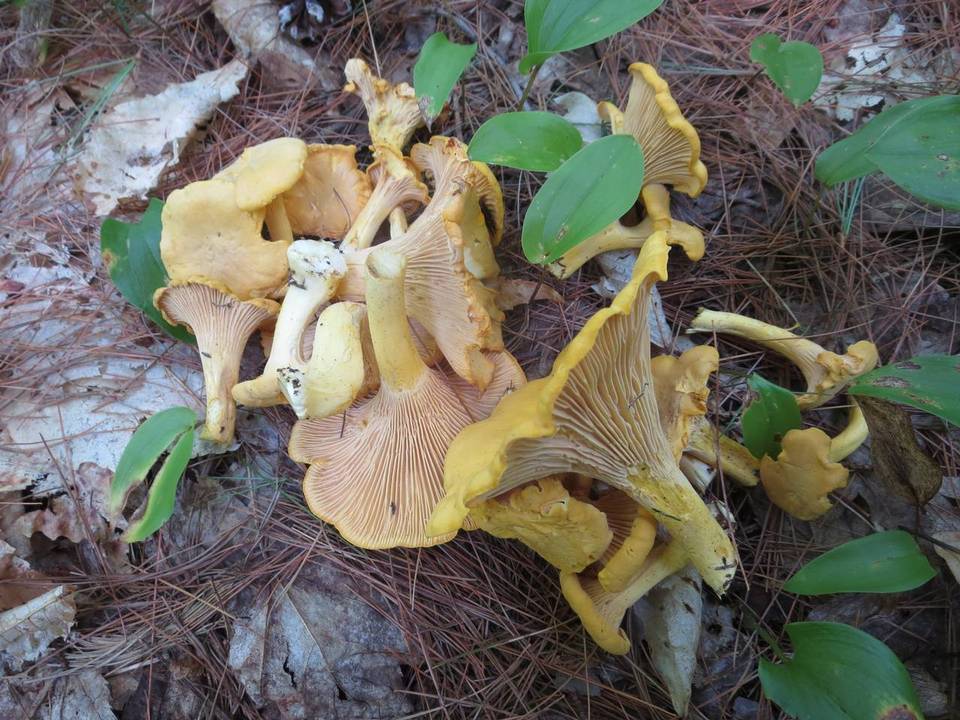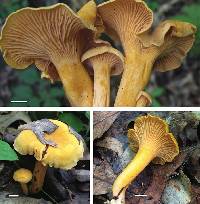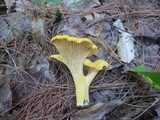
|
|
|
|
Family: Cantharellaceae
|
Foltz MJ, Perez KE, Volk TJ. 2013. Molecular phylogeny and morphology reveal three new species of Cantharellus within 20 m of one another in western Wisconsin, USA. Mycologia 105: 447-461. Cantharellus spectaculus M.J. Foltz & T.J.Volk, sp. nov. Fig. 2A, B, C, SUPPLEMENTARY FIG. 5 MycoBank MB800427, C0171590F. Pileus orange-salmon; hymenium salmon, sometimes with a purple hue; spore print salmon-pink and larger than C. phasmatis. Molecular data from nLSU and TEF1 loci distinguish this species from all other Cantharellus (Figs. 3, 5). Etymology: named spectaculus for the unusual salmon-pinkish, sometimes purple hymenium and orange stalk, a showy combination. Holotypus: UNITED STATES. WISCONSIN: La Crosse County, Hixon Forest Park, along the path parallel to Bliss Road, approximately halfway up the path on right side, associated with oak in oak-hickory mixed deciduous forest, N43.8157° W91.2091°, 18-VII-2010, here designated Foltz C081, Collection CS001, C0171590F. Pileus orange/salmon, 4–8 cm diam when mature, usually circular but sometimes elongated, umbraculaform when young, becoming plano-convex to depressed/infundibuliform with maturity, pileus surface textured or subtomentose under a hand lens, context thin, similar in color to pileus but more pale; margin incurled, becoming wavy with age, usually regular; lamellae salmon/pink, sometimes with purple hues under certain light, often forking and sometimes anastomosing; stipe orange and solid, white at the base, slender and usually as long or longer than the diameter of the pileus, context whitish, with cortex tissue similar in color to the surface; spore deposit salmon-pink, 10–12(14) × 5–7 μm, oblong-elliptical when mature (n = 30); basidia (104)110–120(125) × (9)10–11 μm, mostly 4(5)-sterigmate, clavulate, sometimes with clamps at the base that stem new basidia directly from the clamp; pileus hyphae terminal cell (52)60–65 × 4.5–5.5 μm; clamps found in all tissues. Habitat, habit and distribution: cespitose to gregarious; associated with Quercus (Fagaceae) and Carya (Juglandaceae) (oak-hickory); Jul–Aug, rare in the type locality in Wisconsin. Edibility: choice. Additional specimens examined: None found beyond the type collection. Comments: This chanterelle can be distinguished from other chanterelles by its salmon hymenium, orange stalk, lack of egg-yellow pileus, salmon-pink spore print and larger spore. We suggest the common name “Spectacular chanterelle” for this species based on its unusual color combination. |




























